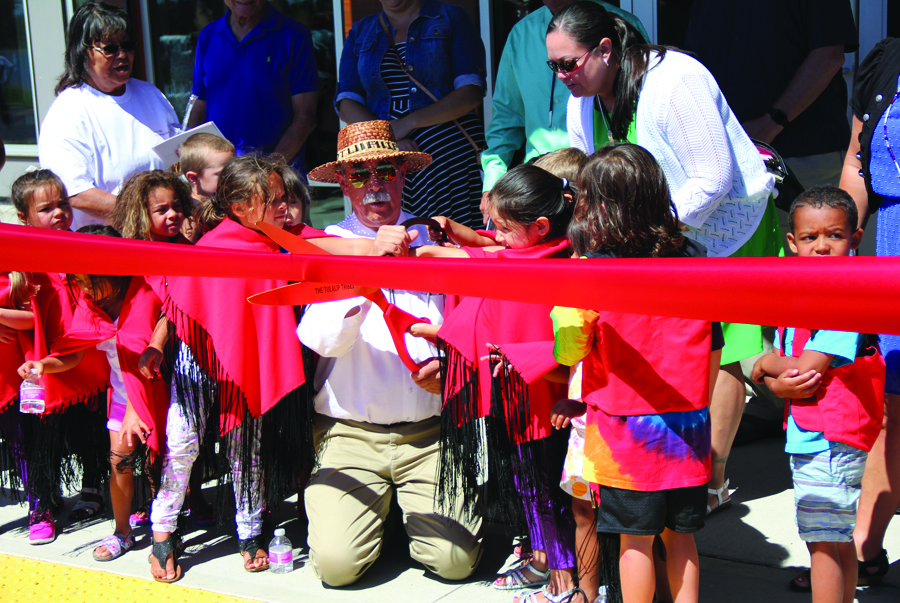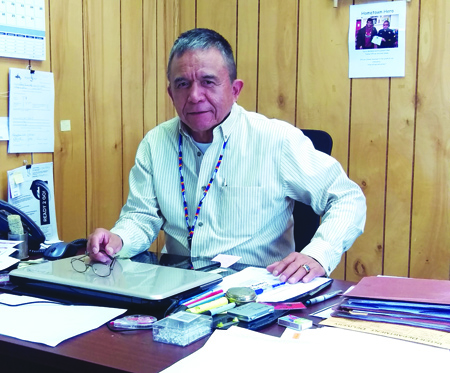Click on the link below to download the August 19, 2015 syəcəb
August 19, 2015 syəcəb
syəcəb
Tulalip,
I want to address a subject that weighs heavy on our community right now; the buzz currently in the media regarding Tulalip citizens accused of trafficking in illegally harvested shellfish.
Every citizen has a right to a fair and impartial trial, and the Tulalip Tribes protects our citizens’ rights by refraining from speaking about current investigations. Facts about the case will be available after the case goes to trial and a judgment is made.
The State did recognize our jurisdiction. The State went through Tulalip Court to obtain search warrants for an investigation that involved Tulalip citizens. The State recognizes both our interest in this case, as well as the authority of our judicial system.
Tulalip has jurisdiction over all fishing violations committed by Tribal fishermen within our usual and accustomed areas. The Boldt Decision reaffirmed that inherent right, and Tulalip is exercising that right by prosecuting 8 different cases of fishing in closed waters, not just the case that you’ve seen in the media. The State has not filed any charges to date.
We exercise our sovereignty by creating and enforcing our laws. Laws that apply to every citizen, and laws that were created for the benefit of every citizen. Just as our ancestors did, we use our knowledge of the resource to determine when to open fisheries so that our people can enjoy that resource, while leaving enough to ensure the future of the resource.
Regardless of whether it was harvested legally or illegally, for subsistence, financial or personal gain, every bit of our natural resources harvested by Tulalip citizens are counted as part of 50% of the catch that tribes are entitled to. Every fish that is taken illegally, is taken from the mouths of other Tulalips.
The Tulalip Tribes will prosecute Tulalip citizens who take from our families. We will prosecute crimes that endanger the co-management of our resource. We will exercise our sovereignty and enforce the laws that we created to protect our people.
I’m encouraged by all of the conversation. I’m gratified to know that our citizens are as engaged in protecting our sovereignty as our grandparents were.
Mel Sheldon
Chairman, Tulalip Tribes
 The 2-day festival, with a focus on wine, food and tradition, begins with the Friday night wine and passed hors d’oeuvres reception, followed by the fittingly named Celebration Dinner. The multi-course repast celebrates “La Famiglia,” as the Italians say, it’s all about “the family!” The evening’s inspiration comes from the love of Italian grandmothers everywhere who have a special passion for cooking amazing food every day for their families. In tribute, Tulalip chefs will recreate many of their beloved recipes, paired with a global offering of rare, top wines. Friday night’s Celebration Dinner is priced at $225 per person, and tickets are limited.
The 2-day festival, with a focus on wine, food and tradition, begins with the Friday night wine and passed hors d’oeuvres reception, followed by the fittingly named Celebration Dinner. The multi-course repast celebrates “La Famiglia,” as the Italians say, it’s all about “the family!” The evening’s inspiration comes from the love of Italian grandmothers everywhere who have a special passion for cooking amazing food every day for their families. In tribute, Tulalip chefs will recreate many of their beloved recipes, paired with a global offering of rare, top wines. Friday night’s Celebration Dinner is priced at $225 per person, and tickets are limited.
On Saturday “All Access” pass holders ($350 per person) will enjoy early entrance to the unforgettable Grand Taste and Rock and Roll Challenge; a wine seminar — Washington State AVA Smackdown featuring some of the State’s tops wine producers, hosted by superstar wine guy, Anthony Giglio. Also featured, a VIP seminar featuring Chef Chris Cosentino’s cooking demo, table talk and Q & A session on the Albert Lee Appliance Cooking Stage; and a private Magnum Party where guests will be treated to a selection of high level wine and food pairings.
The weekend’s highlight is always the Grand Taste, spanning four hours and featuring lavish food stations, as well as over 100 wines from Washington state, Oregon, California, Oporto, Maderia, global selections of bubbles, as well as pours of late harvest and ice wines and craft beer. Grand Taste is priced at $110 per person and includes the edgy Rock -n- Roll Cooking Challenge – a fast-paced culinary roller coaster with slammin’ rock and roll music! Expect fun and great tunes as local Seattle and Tulalip Chefs and Sommeliers compete “Iron Chef” style with celebrity judges (Chef Chris Cosentino, Chef Thierry Rautureau, Chef T, and Mauny Kaseberg), who are looking for the best dish and wine pairing. This year’s emcee will be the famously entertaining Chris Cosentino from San Francisco’s Cockscomb and Boccalone, along with wine writer, educator and raconteur, Anthony Gigilo. This show-stopping cook-off is sure to keep things lively and the chefs on their toes!
To top off the weekend, Thompson will also feature an in-depth reserve wine tasting/seminar called “Turning Water Into Wine” with Sparky and Sarah Marquis of the award-winning Australian winery, Mollydooker Wines. The tasting line-up will include 12 of Mollydooker Wine’s recently released 2014 wines. Tickets are priced at $125 per person and are available for purchase by calling (360) 716 1239.
And now for the stars of the Taste of Tulalip Wine + Food Celebration weekend…
Sommelier Tom Thompson – Tulalip Resort Casino
Tulalip Wine Director Tom Thompson is always first in line to uncork the latest and greatest boutique finds. He has carefully selected well over 100 pours from Washington, Oregon, California, Germany, and New Zealand for the “Wine Event of the Year”, as recognized by the Washington Wine Commission. Thompson continues to add breadth to Tulalip’s extensive cellar, garnering Wine Spectator’s Best of Award of Excellence.
Executive Chef Perry Mascitti – Tulalip Resort Casino
Executive Chef Perry is the man behind the pan! He oversees seven dining venues, in-room meals for the Four Diamond hotel and catering for the entire Resort Casino. His creativity shines along with that of his culinary team at the multi-course Celebration Dinner, the nibbles of endless proportions at the Grand Taste, and he is the mastermind behind the Rock and Roll Challenge.
Chris Cosentino – Guest Chef
Chris Cosentino, aka @OffalChris, is the Chef/Owner of Cockscomb and Boccalone and an Award-Winning Chef and Cookbook Author. Cosentino is a graduate of the culinary program at Johnson & Wales University and went on to build his résumé at Red Sage in Washington, D.C. and Rubicon, Chez Panisse, Belon, and Redwood Park in the San Francisco Bay Area. Cosentino took his first executive chef position at Incanto in 2002 where his inspired and innovative interpretations of rustic Italian fare promptly earned the restaurant both critical and popular acclaim. Cosntino’s debut on BRAVO’s “Top Chef Masters” series was a huge success earning over $140,000 for the Michael J. Fox foundation for Parkinson’s research and being named the season four winner. And in 2012, he saw the debut of his first cookbook “Beginnings: My Way to Start a Meal”.
Anthony Giglio – Wine Expert
Anthony Giglio is a writer, educator and raconteur who motivates countless imbibers to trust their own tastes and relax the rules. Giglio’s witty, unpretentious style can be discerned in the weekly column he writes for Details Magazine’s “Food + Drinks” section. He has written 10 books, including three editions of the annual FOOD & WINE MAGAZINE Wine Guide review of 1,000+ wines; five editions of the enormously popular Mr. Boston Official Bartender’s Guide; and his highly-regarded first book, Cocktails in New York.
Mike Gobin – 2015 Taste of Tulalip Featured Artist
Native American artist Michael Gobin meticulously uses his hands and knives to carve the Pacific Northwest’s indigenous red and yellow cedar trees in an effort to bring the sacred wood back to life. A treasure to the community, Gobin skillfully resurrects Tulalip’s traditions and ancestral stories through his works of art.
Kerry Shiels – 2015 Honorary Winemaker Côte Bonneville
After earning her Engineering degree, Shiels worked for two years in Torino, Italy, and then moved on to Case New Holland’s world headquarters in Chicago for 18 months before entering the world of wine. From there, Kerry worked the 2006 vintage at Joseph Phelps Vineyards, 2007 harvest at Australia’s Tahbilk, and then went on to work the 2007 vintage at Folio – Michael Mondavi’s Napa winery. During the 2008 harvest, Shiels served as the assistant white winemaker to Rich Arnold at Robert Mondavi Winery, followed by the antipodal 2010 harvest at Tapiz in Argentina, and then finally returning home to work full-time at Côte Bonneville.
Bill Wixey – Emcee
Having grown up in the Pacific Northwest, Bill feels privileged to chronicle the issues that affect his community. A newsroom leader, he has anchored and reported in the Seattle area since 1998, and is co-host of This Morning on Q13 FOX News weekdays from 7 to 10 a.m. Offering commentary on major news events from all over the world, Wixey has reported from Asia following the 2004 tsunami, from Haiti after the 2010 earthquake and covered the Olympic Games in Beijing, Vancouver and London. He has been honored with two Emmys for his broadcast work.
Kaci Aitchison – Emcee
A Seattle native and proud University of Washington grad, Kaci picked up her first microphone as a sophomore, and hasn’t put it down since. She got her start in radio at KISS-FM, to meeting the big brothers she never knew she wanted as host on The Bob Rivers Morning Show. In 2009 she joined the Q13 This Morning as a features reporter and is now co-anchor. Voted “Best Local TV Personality in Western Washington”, Aitchison is also one of the lead singers with local rock and roll band Spike and the Impalers.
Thierry Rautureau – Rock and Roll Challenge Guest Judge
For 26 years, Chef In The Hat Thierry Rautureau owned Rover’s Restaurant, which offered cuisine that Rautureau described as Northwest Contemporary with a French accent. Currently, Rautureau is the chef/owner of Luc and Loulay Kitchen & Bar in Seattle, Washington. Rautureau was born in the town of Saint Hilaire de Loulay in the Muscadet region of France. At 20, he moved to the United States and worked at various fine restaurants, including La Fontaine in Chicago, the Regency Club for Joachim Splichal in Los Angeles, and the Seventh Street Bistro with Laurent Quenioux, also in Los Angeles. While visiting Seattle in 1987, Rautureau dined at Rover’s and discovered that the restaurant was up for sale. Tired of Los Angeles, he decided to buy the restaurant so that he could express his culinary creativity as the chef/owner. The rest, as they say, is
history.
Mauny Kaseburg – Rock and Roll Challenge Guest Judge
Mauny Kaseburg is a Northwest-born, Paris-trained food and wine consultant who many will remember from her many years on KUOW radio. In 2015, Mauny celebrated her 28th year as Culinary Producer for the Food & Wine Magazine Classic in Aspen. Mauny also spent five years in the Northern California wine country, serving as Marketing Director for the Russian River Valley Winegrowers. She returned to Seattle in 2008 to marry the merman of her dreams – Geoff Golden.
Chef T (Savuthy Dy) Rione XIII – Rock and Roll Challenge Guest Judge
Savuthy Dy is a graduate of the California Culinary Academy and has worked at The Herb Farm, Qube, Piola y Crota in Italy, and Book Bindery, among others. Rock and Roll Challengers beware – Chef T was on the 2014 Taste of Tulalip Rock and Roll Challenge winning team.
Taste of Tulalip tickets go on sale August 14, 2015. Hotel rooms and spa appointments will become near and dear during this 2-day extravaganza. Reserve a room at the AAA Four Diamond resort by going to www.tulalipresort.com or by phoning 1-866-716-7162. For more information, visit www.tasteoftulalip.com.
The 2015 Taste of Tulalip sponsors include: Delta Air Lines, Albert Lee Appliance – Bosch and Thermador, Dillanos Coffee, Mercedes Benz of Lynnwood, Coke, Le Creuset, Seattle Magazine, and Tasting Room Magazine.
About Tulalip Resort Casino
Award winning Tulalip Resort Casino is the most distinctive gaming, dining, meeting, entertainment and shopping destination in Washington state. The AAA Four Diamond resort’s world class amenities have ensured its place on the Condé Nast Traveler Gold and Traveler Top 100 Resorts lists, as well as Preferred Hotel & Resorts membership. The property includes 192,000 square feet of gaming excitement; a luxury hotel featuring 370 guest rooms and suites; 30,000 square feet of premier meeting, convention and wedding space; the full-service T Spa; and 6 dining venues, including the AAA Four Diamond Tulalip Bay Restaurant. It also showcases the intimate Canoes Cabaret; a 3,000-seat amphitheater. Nearby, find the Hibulb Cultural Center and Natural History Preserve, Cabela’s; and Seattle Premium Outlets, featuring more than 110 name brand retail discount shops. The Resort Casino is conveniently located between Seattle and Vancouver, B.C. just off Interstate-5 at exit 200. It is an enterprise of the Tulalip Tribes. For reservations please call (866) 716-7162.

By Micheal Rios, Tulalip News
On Friday, August 7, the much anticipated grand opening was held for the Betty J. Taylor Early Learning Academy. The event marked the culmination of over a decade’s worth of planning, devotion, and perseverance by countless individuals committed to helping local community families make a lasting, positive difference in their children’s education. In partnership with parents and community, the caring and experienced Tulalip Tribes teaching staff created a loving and safe environment where children and families can grow in academically. The Betty J. Taylor Early Learning Academy (ELA) provides no cost educational schooling from 9:00 a.m. – 3:00 p.m. Monday through Thursday for children ages birth to 5 years-old.
“In 1999, Les Parks and I took a very transformative trip to Philadelphia to look at a learning academy,” recalls Mel Sheldon, Tulalip Chairman. “We think about education and what it means to our kids, what it means to our community, and how we create safe environments for learning. I look at this building and I see nothing but good vibrations and endless possibilities for our young ones. What a great site for the school here. Our youth are going to have memories that will go long into their life with their teachers, their parents, and all the learning that they’ll be doing.”
A large community attendance, along with representatives of Marysville School District and Washington, D.C. dignitaries, turned out to witness the debut of the gorgeous 52,000 square-foot Early Learning Academy. The facility, oriented towards views over Tulalip Bay and the surrounding woodlands, sits on nine acres of land and is designed to symbolize the tribe’s commitment to a healthy community and a strong foundation for our children’s education. Tribal artists worked with the project team to incorporate artwork on the site and within public spaces of the building to reflect the cultural context being infused into our idea of early learning. Tulalip artwork is clearly visible in the stunning, etched-glass panels provided by James Madison, the blue glass wave directly above the reception area, and the river designed walkway throughout the academy.

“To me, this day has been 17 years in the making. It’s been a dream that we’ve all had,” details Les Park, Tulalip Board of Director, to the hundreds of attendees. “Research tells us that 90% of a child’s brain development happens before age five. Ever so true that is, our kids are capable and eager to learn at a very early age. We’ve known this and in response have created several different programs that touch on early learning, but this is the building where we are going to take it to a new and higher level, which I think is going to change our membership in the future. A generation from now, when these kids have grown up and are leading our tribe, they would have learned so much more than they would have, had they just waited to enter the public school system. It’s so exciting for me to witness this, a 17 year vision come to fruition today as we bring an early learning academy to Tulalip.”
Far too many children enter public school kindergarten unprepared for the drastic changes in routine and academic expectations. When children begin school unprepared it’s only a matter of time before they fall behind, and they tend to fall further behind as the school year progresses. All children need to enter school ready and able to succeed, which is why early education is so important. Cognitively, early education improves school performance, raises math and language abilities, and sharpens thinking and attention skills. Early learning also has plenty of social and emotional benefits as well. Children will improve and strengthen their interactions with peers, decrease problem behaviors, and helps adjustment to the demands of formal education.
With the opening of the Early Learning Academy, we fully expect all the added benefits and rewards of early learning to materialize for our children. However, those aren’t the only benefits of the ELA, as many new and exciting changes will be instituted to the way Tulalip will approach educating our young children. One such change is the moniker of the students who will attend the ELA, who will be affectionately known as the ‘Children of the Salmon’. The foremost game changer is the consolidation of all birth to five-year-old programs into one program, under one roof.

“We have brought all our birth to five programs out of their silos and brought them together into one, singular program with the same focus,” explains Sheryl Fryberg, ELA Manager. “We’ve redone all of our policies, procedures, and intake forms to reflect this. We are now the Betty J. Taylor Early Learning Academy. We’re not Montessori, we’re not ECEAP, and we’re not Early Head-Start; we are one.
“This academy is open to all of our tribal kids. In addition to our tribal kids, our service area is Marysville School District, so if your family is within the Marysville School District then your eligible to apply here.”
ELA will be using the Creative Curriculum, but utilizing different strategies. Teaching staff will utilize the Teaching Strategies assessment tools to show the progress that all of our children are making. This curriculum assures that the academy remains aligned with the school readiness early learning content standards, while doubling as a means to provide constant feedback on students’ progress.
“We will be utilizing a new child evaluation system, so that we can keep track of where our kids are with their learning,” explains Sheryl Fryberg. “Assessments that all our teachers will be using from birth to five will measure our students’ growth in different areas and stages. This process will make it possible for us to create custom and, if need be, individualized lesson plans from the assessment results to ensure we don’t allow any children to lag behind or fall into the gaps. Our top priority is to provide the best educational foundation as possible for each and every ELA student.”
Another big change, that undoubtedly will take some time for parents and students to adjust to, is the switch to a year-around school system. There will be no 2.5 month long summer break for students of the Early Learning Academy, instead there will be four school closures throughout the year. A one-week break will occur in December, April and June, while a two-week break is expected in August.

“Research shows that when you do year-around schooling the children do much better academically, and what better time to have them transition to year-around school then while they are getting adjusted to the Early Learning Academy,” continues Fryberg. “I feel like we are laying such a strong foundation for our kids and the families to be involved in their kids’ education. The research has shown that when kids are off school for 2.5 months that they lose so much of what they’ve learned. You’re almost starting all over when they come back to school in the fall, so this move to year-around education will be such a huge benefit to the future academic success of our children.”
The academic success of our children is at the forefront of every idea and strategy that will be implemented in the ELA’s curriculum. The cultural tie-ins will remain and even be pushed to new limits, especially when it comes to teaching and learning the Tulalip language, Lushootseed.
“We’re working with the Lushootseed department to develop an immersion classroom,” says Fryberg. “We haven’t worked out all the details just yet, but for 18-months to 3 years-old we want one classroom for three hours a day, all the children do is speak and hear our Lushootseed language. Then we want to follow that group up, continuing to offer them Lushootseed immersion, and see what the end results are. If it’s successful, then we can find grants to really grow a Lushootseed immersion program.”

One vision leads to another. As the ELA opens its doors to the children of our community and promises long-term positive results, one can’t help wonder what the future holds for the cohorts of birth to 5 year-olds whose education and future academic prospects just got a whole lot brighter. Time will determine just how big an impact the ELA’s foundation will have on the tribe’s future, but for now let us just appreciate all the people and effort that made the ELA possible.
“There were so many people involved, who came together as a team to make this vision a reality,” proclaims Misty Napeahi, General Manager of the Tulalip Tribes. “It’s not easy when we’ve had separate programs run as individual programs with different teaching models for all these years. We know the commitment to the children will supersede all obstacles and that our teaching staff will all be working together to serve our children. It couldn’t be done in a better facility. This building is absolutely gorgeous. This dream came true because of all the hard work of our maintenance and construction teams, our teaching staff, and all those who were involved behind the scenes. Because of you all, our children will be here for years to come.”


By Brandi N. Montreuil and Niki Cleary, Tulalip News
The Tulalip Tribes Probation Department is an integral component to Tulalip Tribal Court. A kind of cross between a counselor, cheerleader, champion and hall monitor, the probation staff are a bridge between the court and the client.
“I like to think that orders of the court are geared towards helping people make better choices and probation is the arm that helps them understand what they’re required to do,” explained Tulalip Chief Judge Theresa Pouley. “When you are found guilty of a crime the court is going to give you a list of requirements. We can trust that you’re going to do it, or someone can help monitor whether you comply and help you problem solve ways to be in compliance.
“The Probation Officer receives a copy of the judgment and sentence, which lists all of the things the client has to do. Probation also informs the court when they aren’t doing what they’re supposed to do.”
Tulalip Associate Judge Ron Whitener followed up, “They also advocate for their clients with us [the judges] because they know the true circumstances of their lives. Even though someone might be out of compliance, probation might say we want to come up with a plan to stay in compliance.”
Probation is a complex concept and the reasons that a client receives probation are as varied as the reasons that bring clients into the court. Probation can be a way to give clients a chance to make good without jail time or other sanctions. It can be a way to transition clients back to the community more successfully. Or it can be a way to keep in touch with those at high risk of re-offending, so they don’t simply do their time and slip quietly back into the community to carry on with their former criminal activities.
Judge Pouley gave an example of a non-violent offense that might receive probation, “For a class E offense, possession of a controlled substance there is a maximum penalty of 365 days of jail and a $5,000 fine. It doesn’t do anyone any good to put a first time offender in jail for 365 days and charge them $5,000. If they’re a first time offender, you really want to figure out how to get them treatment. For someone with substance abuse issues, it’s not always easy to make good on your promises [to get treatment], probation helps them do that.”
Judge Whitener described how the relationship between a client and the probation officer can provide positive peer pressure that encourages clients to succeed.
“People, especially with substance abuse, need that structure. The knowledge that they have a person who is going to check on them, knowing that tomorrow I have to go talk to [my probation officer] and he’s going to know, from my chemical dependency counselor, whether I’m going to my sessions. He’ll know if I paid my fine. That makes it easier for the short term.”
Judge Whitener continued, describing probation as a tool to do what is best for the community and the client.
“It’s a system of harm reduction and rehabilitation,” he said. “You want to rehabilitate [the client] and you want to reduce harm to the community. You could put them in jail, but it would be a huge cost. You really want to find out what is going to work for the individual and that’s what probation does. They get to know their clients. They do an assessment of individuals and come forward with a tailored plan for what is going to have the best likelihood of success.”
He described probation as a form of cognitive behavioral therapy, “You rewire the brain towards the positive way of living, rather than the negative. You’re reinforcing a positive lifestyle, you are also being consistent and you have sanctions [when a client doesn’t follow through].
“There’s no magic pill that can solve the problem. It takes lots of hands and some time,” he continued. “It takes a lot of work, sometimes it takes multiple criminal charges and a few times on probation. And sometimes it never happens. We always want there to be a solution. We have to accept that for a lot of people, their lives get better, for some people it doesn’t.”
For violent offenders or those at high risk of reoffending, Judge Pouley explained that sometimes the ratio of sentencing and probation is a balance between holding the offender accountable for their actions, and having an avenue to regulate their actions once they’ve served their time and/or paid their restitution.
“For the vast majority of our clients, we view our role as encouraging people to make good choices and discouraging bad choices. However, there are a small percentage of the clients that are a danger of the community,” she said.
“Most people in that category do up-front jail time as a sanction,” Judge Pouley explained. “But putting someone in jail for 365 days and then on day 366 having no supervision whatsoever isn’t always the best. You want to the sanction to show that you’re serious about not hurting people, selling drugs or being a sex offender, but at the same time you want some supervision afterwards to monitor them for the safety of the community. You want to make sure they’re taking the classes they’re supposed to be taking, but also staying away from the areas they’re supposed to stay away from.”
“We love what we do and we’re trying to help people make better choices,” Judge Pouley recapped. “When it works, it’s such a fabulous thing. And when it doesn’t, it’s pretty heartbreaking.”

Both judges expect that changes in the probation officer may make probation an even more effective tool for clients. For the first time ever, a Tulalip citizen is serving as the probation officer. Tulalip tribal member Andy James is replacing longstanding Probation Officer Jim Furchert. Andy brings with him not only his skills as a United States Marine, but also fourteen years of experience as a Tulalip police officer and he’s already a staple in the courtroom where he’s served as the Transport Officer and Court Bailiff. Known for his fatherly advice and strong cultural teachings, Andy is a natural fit.
“Of the great things about Andy is that he used to do this as Transport Officer,” Judge Pouley described. “He’d give words of wisdom like any elder in your family might give. We’re pretty excited to have Andy and his experience change the dynamic in Probation. He has a really vested interest in the community. He knows the clients and families and brings that depth of knowledge and law enforcement experience to the probation officer job.”
Judge Whitener agreed, pointing out that Andy’s standing in the community will help make the Probation Office more relevant.
“The one thing Probation hasn’t had is the voice of an elder that’s familiar with the community,” he said. “For our clients, someone like that telling them what they need to do resonates more than someone who doesn’t have the same status in the community. It’s a great thing to have his perspective.”
Andy already plans to incorporate culture and tradition as a way to empower clients. He hopes the integration of traditional culture will help break down the institutionalized feeling that many clients have about probation.
“Before, I only had parts of the puzzle,” explained Andy, describing his former role as court bailiff. “Now I have to go through all the client files and make recommendations. I have the whole puzzle to work with now.”
Andy has always used his time with clients to encourage them to comply with court orders and become involved with their culture as a way to heal.
“In some ways it’s identical,” said Andy, comparing previous work with Tulalip Police to his new position as probation officer. “I am dealing with someone’s life.”
As probation officer, Andy is responsible for monitoring over 180 clients, with the assistance of two additional staff members. He has to provide sentencing recommendations, not only in Tulalip Tribal Court, but also state, federal and other tribal courts. The Probation Department coordinates with a variety of tribal entities including the Tulalip Central Drug and Alcohol Testing Department, Behavioral Health Services, and various State and Federal probation and correction departments.
Andy will spend the next few months orientating himself with each client file and new probation software.
“This is a hard job,” said Andy. “I am not perfect and I stress that to clients. I will treat them with respect and let them know we all make a difference, and we all have a purpose.”
By Daniel Davis, Townhall.com
Durango, Colorado declared a state of emergency yesterday after the EPA accidentally contaminated a local river with 3 million gallons of waste. The Animas River has turned orange, and residents living along its banks have been warned to avoid it.
The accident began Wednesday last week when EPA workers accidentally leaked a local mine, releasing concentrated minerals into a stream. The mine had been abandoned for about 10 years, and ground water had accumulated inside it. EPA workers were there to clean up the mine. Now, the mine is leaking at 500 gallons per minute. It still hasn’t been contained, though workers are treating the nearby ponds where the minerals are leaking.
The EPA has tested the polluted water and reports arsenic levels at 300 times the normal level, and lead levels at 3,500 times the normal level. Both arsenic and lead pose significant dangers to humans when highly concentrated. The local sheriff has warned local residents to stay away from the river. The contaminants move along the river fairly quickly, they will not completely pass until the mine leak is plugged.
Many people who live along the Animas River depend on private wells for their water, but those are now threatened by the river’s pollution. The EPA is sending materials to these residents so that they can test their well water for cleanness.
The water pollution has flowed straight into the territory of the Navajo Nation, a semi-autonomous reservation Native American reservation spanning parts of northern Arizona, New Mexico, and southern Utah. The spill is already threatening the livelihoods of many Navajo residents, and the nation has declared its own state of emergency. It even looks to be preparing for a lawsuit against the EPA — the Navajo Nation Commission on Emergency Management has directed the tribe’s Attorney General to assemble a legal team to address the grievances of local residents:
Navajo Nation Council Speaker LoRenzo Bates told the Daily Times that residents were concerned about drinking water safety, river access, water for livestock and crops, and the possibility of compensation for failed crops. With irrigation canals shut off, many farmers are concerned about their next step, Bates said.
“If these farmers don’t get water in the next week, they’ll lose their crops,” he said.
The plume of orange waste has already reached three states, and is expected to reach a fourth by Wednesday. As USA Today reports:
Mustard-colored water flowed this week into Cement Creek, a tributary that runs through Silverton [Colorado] and into the Animas River. In New Mexico, the plume of pollution entered Aztec early Saturday morning and Farmington later that morning. Officials said they expected it to reach the Utah border on Monday and Lake Powell, in Arizona, late Wednesday.
New Mexico Gov. Susana Martinez toured the damage in Farmington, NM over the weekend. She was stunned by the disaster:
“The magnitude of it, you can’t even describe it,” she said, CNN affiliate KRQE reported. “It’s like when I flew over the fires, your mind sees something it’s not ready or adjusted to see.”
Equally stunning was the EPA’s slow response in notifying states of the disaster. New Mexico officials got their first word of the disaster from Native American officials. By the time they heard from EPA officials, it was 24 hours after the spill had begun. Gov. Martinez commented:
“It’s completely irresponsible for the EPA not to have informed New Mexico immediately.”
By Kevin Burbach, Associated Press
SIOUX FALLS, S.D. (AP) – A Native American tribe from South Dakota will return a $25,000 donation from a charitable arm of the NFL’s Washington team, saying the team name is “derogatory and inappropriate.”
The tribal council of the Cheyenne River Sioux Tribe voted Wednesday to return the check, which was issued last month by the team’s Original Americans Foundation to the tribe’s rodeo association.
“A lot of those in our community are opposed to accepting money from the R*dsk*ns, which to us is a racist organization; the term is derogatory and inappropriate,” said Ryman LeBeau, the tribe’s vice chairman and a councilman. “Their fans make a mockery of Indian culture, and that’s just wrong.”
The foundation was created in March 2014 by team owner Dan Snyder following intensifying calls by Native Americans and other groups for the team to do away with its name. The team has maintained that it is meant to honor Native Americans, though a federal judge in June ordered the team’s trademark registration be cancelled, saying there is ample evidence that the name may be perceived as disparaging. However, that ruling does not preclude the team from using the word.
It wasn’t immediately known how many tribes have received donations from the foundation, but team spokesman Maury Lane said the majority of tribes are happy to accept such help and typically put the money toward improving things like transportation, education and football camps.
“The Original American foundation has been working with more than 50 federally recognized tribes, spending millions of dollars on more than 250 projects on tribal lands,” Lane said. “Our mission remains to improve the quality of life on these lands without interfering with tribal governance.”
The Cheyenne Sioux’s fair and rodeo board had passed a motion to allow Tribal Chairman Harold Frazier to seek money from the foundation but hadn’t brought the check to council until this week, LeBeau said, adding that Frazier has met personally with Snyder and the charitable arm.
Included in the motion voted on this week is language that bans Frazier from “unsanctioned communication” with the team or any group or person associated with it. Messages left at Frazier’s office were not immediately returned.
LeBeau, who says the central South Dakota tribe has areas he feels need improvement, doesn’t think it’s right to accept money from an organization that many feel doesn’t support them.
“It just feels like they want to buy us off and keep us quiet,” he said, noting that he knew of only a few people in the approximately 16,000-member tribe supported accepting the check.
Lane maintained that the vast majority the foundation’s donations are well-received.
“This is definitely an anomaly,” he said.
Earlier this year, the Paiute Indian Tribe of Utah ousted a tribal chairwoman who was involved with the Original Americans Foundation for misconduct and ethical violations after accepting gifts of an autographed football and a trip to Washington, D.C., to attend a game in 2014.
The foundation also donated two vans to the tribe, which ex-chairwoman Gari Lafferty has said are used to transport children and elders. Lafferty has disputed the tribe’s allegations.
In South Dakota, LeBeau said the issue is preventing from the tribe from tackling larger issues like drug and alcohol abuse and suicides.
“This is just a (distraction) from working on the bigger solutions that will help our communities with the issues that are really affecting us, he said.”
Water – how much we have and how clean it should be – is on the minds of many these days as the drought rolls on in western Washington and state government remains stalled on updating decades-old water quality standards.
Tribal insistence on more restrictive salmon fisheries this year has turned out to be the right call as the hottest and driest summer we’ve ever seen continues, threatening salmon throughout western Washington at every stage of their life cycle.
With no snowpack, record warm weather and little rain, our rivers and streams are running low, slow and hot. That’s bad news for both hatchery and wild salmon, which depend on plenty of cool water for their survival.
Many returning adult salmon died last year before they could reach spawning grounds or a hatchery, while thousands of out-migrating young salmon died before they could reach the ocean. The deaths of those salmon will be felt by all fishermen several years from now when fewer fish return.
Water temperatures 70 degrees and higher can be lethal to salmon. Many streams already have reached those temperatures with a lot of summer left. Warm water can also create a thermal barrier that prevents salmon from reaching hatcheries and spawning grounds. In addition, salmon are more susceptible to diseases when water temperatures are high.
Salmon are getting some relief from tribal and state hatcheries that use cooler groundwater for incubating and rearing fish. These hatcheries are providing sanctuaries to help salmon survive the drought and fulfilling their role as gene banks to preserve salmon for the future.
The outlook for many tribal fisheries is growing steadily darker as week after week slips by with no improvement in weather conditions. We hope enough salmon will return to our fishing grounds so that we can feed our families and preserve our cultures and communities.
It wasn’t easy for the tribes to convince the state co-managers that tougher fishing regulations were needed this year to protect salmon. In fact, the Puget Sound sport-fishing industry was prodding the Washington Department of Fish and Wildlife to expand fisheries this summer. But salmon management is not a popularity contest and the effects of our drought are getting worse.
The treaty tribes in western Washington will continue to insist on the highest level of responsible fisheries management and hatchery operations to ensure all of our children have a future that includes salmon.
On the water quality front, the state legislature adjourned a triple overtime session in June without approving Gov. Jay Inslee’s proposal for new water quality standards as part of a statewide toxics reduction program.
State water quality standards already are more than 40 years old. The state admits that current standards don’t adequately protect any of us, especially those of us who eat a lot of fish and shellfish. The state has missed every deadline to update the standards as required by the federal Clean Water Act.
Inslee’s toxics reduction program is a good idea. It’s a lot easier and cheaper to prevent poisons from ever getting into our waters than to clean them up afterwards. But to be effective, such a program must first be based in a strong rule of law that will drive the compliance and innovation needed to meet those standards.
The governor is expected to propose a new set of water quality standards in early August. If not, the U.S. Environmental Protection Agency will step in to help.
It is important to remember that all natural resources are connected. Water quantity and quality are two sides of the same coin. Both are fundamental to the health of people and salmon.
Protecting and restoring salmon habitat improves the overall health of our watersheds, making them more resistant to drought and able to bounce back more quickly from its effects.
To truly protect our water quality and quantity – and to protect and restore the salmon resource – we must continue to work together to restore salmon habitat. At the same time, we should develop strong rules that can support a statewide toxics reduction program with realistic, truly protective water quality standards that are implemented over time.
Komplex Kai, a Native Emcee from Tulalip, is part of the “Don’t Funk Up Our Beats” contest from HipHopDX and Funk Volume. Check out his video featuring the song, The First, from his 2010 album Mask’d Dreamz.
You have until August 23 to visit hiphopdx.com and cast your vote. Contestants need 250 votes to eligible to be selected as a finalist, so spread the word and listen to his beats.
Additional Komplex Kai videos can be found on YouTube and you can follow him on Facebook.